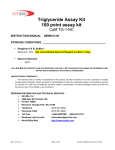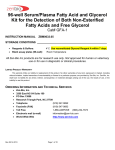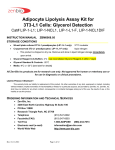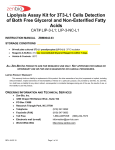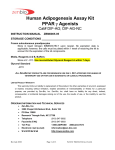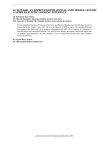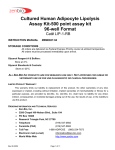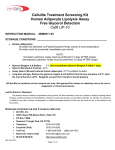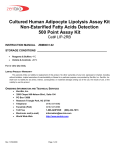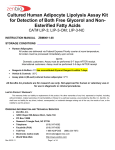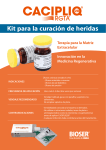Download (TG-5-RB) - Zen
Transcript
Triglyceride Assay Kit-Bulk 500 Point Assay Kit, 96 well format Cat# TG-5-RB INSTRUCTION MANUAL ZBM0014.05 STORAGE CONDITIONS Reagents A & B, Buffers: Store at 2 - 8C. Use reconstituted Glycerol Reagent A within 7 days. Glycerol Standard -20°C ALL ZEN-BIO INC PRODUCTS ARE FOR RESEARCH USE ONLY. NOT APPROVED FOR HUMAN OR VETERINARY USE OR FOR USE IN DIAGNOSTIC OR CLINICAL PROCEDURES. LIMITED PRODUCT WARRANTY This warranty limits our liability to replacement of this product. No other warranties of any kind, expressed or implied, including without limitation, implied warranties of merchantability or fitness for a particular purpose, are provided by Zen-Bio, Inc. Zen-Bio, Inc. shall have no liability for any direct, indirect, consequential, or incidental damages arising out of the use, the results of use, or the inability to use this product. ORDERING INFORMATION AND TECHNICAL SERVICES Zen-Bio, Inc. 3200 East NC-54 Suite 100 PO Box 13888 Research Triangle Park, NC 27709 Telephone (919) 547-0692 Facsimile (FAX) (919) 547-0693 Toll Free Electronic mail (e-mail) 1-866-ADIPOSE (866)-234-7673 [email protected] World Wide Web http://www.zenbio.com Rev 04.16.2014 Page 1 of 9 PATENT PROTECTED (6,153,432) The contents of this kit are sufficient for the assay of up to five 96 well plates (500 assay points). The protocol is designed for assay of cells in a 96-well format. For other formats, please adjust the volumes added to each well according to the surface area of the well/flask you are using. See your cultureware manufacturer’s technical information for the specifications. ITEMS INCLUDED IN THE KIT Item Wash Buffer Lysis Buffer Reagent A Amount 250 ml 15 ml 40ml 11ml QTY 1 1 1 1 Storage 4°C 4°C 4°C 10ml 2.5ml 1 1 4°C 4°C 100 l 3 -20°C Standards 11 ml Diluent Other equipment/reagents required but not provided with the kit: Single-channel pipetter Multi-channel pipetter Plate reader with a filter of 540 nm Tubes to dilute glycerol standards Disposable reagent trays Mature adipocytes or other cells Clear bottom 96-well assay plates 1 4°C Reagent B Glycerol standard Rev 04.16.2014 Instructions Reconstitute w/ 40 ml deionized water. Reconstitute w/ 11 ml deionized water. Combine and mix before use. Use reconstituted Reagent within 7 days. Reconstitute w/ 10 ml deionized water. Reconstitute w/ 2.5ml deionized water Combine and mix before use. Glycerol @ 1mM [Reconstitute with 400 l Standards Diluent to make the 200 M glycerol standard; see manual for recommended dilution scheme] Page 2 of 9 PATENT PROTECTED (6,153,432) ASSAY PROCEDURE 1. Warm the Wash buffer and Lysis buffer in a 37oC water bath. 2. Prepare the Reagent B by adding 10ml and gently invert. DO NOT VORTEX! Use a dissolved. Keep at room temperature. Store Reagent B is stable for 60 days refrigerated (2-8C). 2.5 ml deionized water to the labeled bottles and pipet to ensure that the powder is completely in a light protected bottle. Reconstituted Glycerol (2-8C); store any remaining solution refrigerated 3. Remove all media from mature human adipocytes. Using about 15 ml of the wash buffer, wash the cells one time with 150 µl wash buffer. Label the disposable tray “wash buffer” and retain for later use. 4. Remove all Wash buffer. Using a disposable reagent tray (not provided), add 15 l Lysis buffer per well. Incubate at 37oC - 50oC for 20 minutes. 5. After the incubation is complete, visually confirm cell lysis by checking the wells under a microscope. If cells are not fully lysed, incubate for another 10 minutes. Sometimes pipet mixing is necessary for full lysis. 6. Add 135 l warm Wash Buffer to each well. 7. Add 20 l Reagent B to each well. It is not necessary to mix at this time, however, gently tap plate to help mix reagents. Incubate the plate at 37oC for 2 hours. 8. One hour prior to the assay, bring the glycerol standard and Reagent B to room temperature. Warm the Standards Diluent to 37C. Prepare the standard curve as follows: Pipette 400 l of the Standards Diluent into the 1 mM glycerol standard tube provided and mix well by vortexing. This produces a diluted stock glycerol standard of 200 M. Pipette 250 l of Diluent into 6 tubes (not provided). Using the newly diluted stock glycerol solution, prepare a dilution series as depicted below. Mix each new dilution thoroughly before proceeding to the next. The 200 M stock dilution serves as the highest standard; the Diluent serves as the zero standard. Rev 04.16.2014 Page 3 of 9 PATENT PROTECTED (6,153,432) 400 l Standards Diluent 250 l 250 l 250 l 250 l 250 l 250 l Std 200 M 100 M 50 M 25 M 12.5 M 6.25 M 3.125 M Note: The above dilution series generates enough volume to perform the standard curve in duplicate. If you wish to perform the standard curve in duplicate, please note that eight fewer data points can be assayed with this kit. 9. Also at this time prepare the Reagent A by adding 40 ml and 11 ml respectively of deionized water to the appropriate bottle and gently invert. DO NOT VORTEX! Use a pipet to ensure that the powder is completely dissolved. Mix and combine the 2 volumes for use in the assay. Keep at room temperature. If using a Glycerol Reagent A solution previously prepared and stored at 2-8C, also bring to room temperature. Make sure there is enough Glycerol Reagent A from one solution to treat all the points in the assay. It may be necessary to combine solutions. Store in a light protected bottle. Reconstituted Glycerol Reagent A is stable for 7 days refrigerated (2-8C); store any remaining solution refrigerated (2-8C). 10. To a blank 96 well plate (not provided), add 80 l Wash Buffer to each well needed for the assay (NOTE: do not add Wash Buffer to the wells used for the standard curve). 11. Working with one row or column at a time, mix the lysates very well using a multi-channel pipet. Immediately transfer 20 l per well of the lysates to the corresponding well of the plate containing the wash buffer. This results in a Dilution Factor of 5. 12. Prepare the standard curve. Pipet 100 l of each standard into a well. (NOTE: Eight wells are necessary for the curve. If there are remaining wells on the assay plate, you can utilize the remaining wells.) 13. Add 100 l Reagent A to samples and standards. Mix by pipetting up and down one time. Incubate at room temperature for 15 minutes. 14. Read at 540 nm using a microtiter plate reader. Rev 04.16.2014 Page 4 of 9 PATENT PROTECTED (6,153,432) GLYCEROL STANDARD CURVE This kit is designed to show relative lipid accumulation of experimental treatments compared to controls. The assay is based on the equation 1 M Triglyceride yields 1M glycerol + Free Fatty Acids The reagent measures the concentration of glycerol released after lysing the cells and hydrolyzing the triglyceride molecules. The triglyceride concentration can then be determined from the glycerol values. Generate standard curve: see example below [DO NOT use this standard curve to generate your data. This is an example.] Subtract the OD value of the 0M standard from all OD values including the standard curve. Glycerol (uM) 0 3.125 6.25 12.5 25 50 100 200 OD 0.048 0.059 0.07 0.098 0.127 0.2 0.353 0.649 slope intercept 2 R 0.003 0.053 0.9997 OD 0.048 0.058 0.07 0.098 0.13 0.205 0.362 0.667 ODblank ODblank 0.011 0.022 0.05 0.079 0.152 0.305 0.601 0.01 0.022 0.05 0.082 0.157 0.314 0.619 Avg ODblank 0.048 0.059 0.070 0.098 0.129 0.203 0.358 0.658 y = observed O.D. minus the blank x = concentration of glycerol in M To calculate x for each y, (i.e. to change the observed O.D. into glycerol concentration) use the following equation: y=(slope) times (x) plus intercept y=mx+b so x=(y-b)/m x=(y – 0.0006)/0.0014 where 0.0014= slope of the line and 0.0006= y intercept. Be careful to enter the proper sign for the y intercept value as it may be a negative number. Any OD values greater than the highest standard (200 M) should be suspect. The compound should be re-assayed using a lower dose of the compound at treatment OR a dilute solution of the condition medium at the time of the assay. Rev 04.16.2014 Page 5 of 9 PATENT PROTECTED (6,153,432) The R2 value should be equal or greater then 0.98 for the standard curve to be valid. Any R2 values below 0.98, must have the standard curve run again. Solve for the Total Glycerol concentration (i.e. total triglyceride concentration) for each OD. Remember to include the Dilution Factor in the equation. Data is expressed as M Glycerol. NOTE: Any OD values that are negative after the blank is subtracted should be considered to be 0 for the OD value. FREQUENTLY ASKED QUESTIONS 1. Can I buy the reagents separately? The only reagents sold separately are Glycerol Reagent A (cat# RGTA-10; RGTA-40) and the glycerol standard for the Triglyceride Assay kit (cat# TG-GLYSTAN). 2. Can I use another plate format besides 96 well? This kit is designed for the assay of A 96 well plate (100 assay points). We do not have a protocol for other formats. 3. Can I use this kit to measure total triglyceride in other cell lines and other human and non-human cells? Yes. The assay is not species specific. As long as the sample concentration is in the linear range, this kit should be able to detect it. 4. My cells did not lyse. What can I do? If cells are not fully lysed, incubate for another 10 minutes at 37oC - 50oC. Sometimes mixing by pipetting up and down several times is necessary for full lysis. 5. I do not have time to complete the assay. Can I freeze the samples? Yes. The cell lysates can be stored at -80C for a maximum of 7 days. Mix the thawed lysates in the plate by pipetting up and down several times. Allow all reagents and samples to reach room temperature BEFORE adding the Wash Buffer and Glycerol Reagent A to complete the assay. Rev 04.16.2014 Page 6 of 9 PATENT PROTECTED (6,153,432) TROUBLESHOOTING Problem High background or the triglyceride reagent turns a darker color before the assay begins. Suggestions Use clean tray and tips Change pipet tips frequently Edge effects Ensure a saturated humidity in the incubator to prevent evaporation from the outside wells Inconsistent OD reading Be careful when pipetting to avoid bubbles. If bubbles persist, burst the bubbles using a large gauge needle prior to reading and read the plate again. Mix the lysates well before transferring the 20l to the Wash buffer plate. REFERENCES 1. Green, H. and Kehinde, O. (1974) Sublines of mouse 3T3 cells that accumulate lipid. Cell 1, 113-116. 2. Hauner, H., et al., (1989) J. Clin. Invest.(84), 1663-1670. 3. Kuri-Harcuch W, Wise LS, Green H. (1978) Interruption of the adipose conversion of 3T3 cells by biotin deficiency: differentiation without triglyceride accumulation. Cell 14:53-58. Rev 04.16.2014 Page 7 of 9 PATENT PROTECTED (6,153,432) APPENDIX A: PLATE LAYOUT A B C D E F G H 1 2 3 4 5 6 7 8 9 10 11 12 Rev 04.16.2014 Page 8 of 9 PATENT PROTECTED (6,153,432) APPENDIX B: TRIGLYCERIDE ASSAY FLOWCHART All media OOOOOOOOOOOO OOOOOOOOOOOO OOOOOOOOOOOO OOOOOOOOOOOO OOOOOOOOOOOO Remove all media from wells. 150 l Wash Buffer 150 l Wash Buffer Wash with 150 l Wash Buffer Remove all Wash Buffer from wells and add 15 l Lysis Buffer/well. OOOOOOOOOOOO OOOOOOOOOOOO OOOOOOOOOOOO OOOOOOOOOOOO OOOOOOOOOOOO Add 15 l Lysis Buffer o Incubate 20 minutes at 37 – 50 C Verify lysis and add 135 l warm Wash Buffer. Mix by pipetting up and down 3 times. Add 135 l warm Wash Buffer OOOOOOOOOOOO OOOOOOOOOOOO OOOOOOOOOOOO OOOOOOOOOOOO OOOOOOOOOOOO Add 20 l Reagent B OOOOOOOOOOOO OOOOOOOOOOOO OOOOOOOOOOOO OOOOOOOOOOOO OOOOOOOOOOOO Add 20 l Reagent B and incubate 2 o hours at 37 C. One hour prior to assay, reconstitute Glycerol Reagent A and prepare standards. Keep all at room temperature. Add 80 l Wash Buffer Add 80 l Wash Buffer to a new plate. Mix lysates and transfer 20 l lysates to the wells containing Wash Buffer. OOOOOOOOOOOO OOOOOOOOOOOO OOOOOOOOOOOO OOOOOOOOOOOO OOOOOOOOOOOO 20 l OOOOOOOOOOOO OOOOOOOOOOOO OOOOOOOOOOOO OOOOOOOOOOOO OOOOOOOOOOOO O O O O O Transfer 100 l of each standard to a new plate. Standards OOOOOOOOOOOO OOOOOOOOOOOO OOOOOOOOOOOO OOOOOOOOOOOO OOOOOOOOOOOO Add 100 l Glycerol Reagent A to samples and standards. GLYCEROL REAGENT A OOO OOO OOO OOO OOO An additional blank assay plate may be necessary for the assay of glycerol standards. o Incubate 15 minutes at 25 C (room temperature). Pop the bubbles in each well. Measure the optical density of each well at 540 nm using a spectrophotometer plate reader. Rev 04.16.2014 Page 9 of 9 PATENT PROTECTED (6,153,432)









